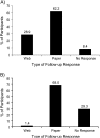Use of a web-based questionnaire in the Black Women's Health Study
- PMID: 20937635
- PMCID: PMC3025633
- DOI: 10.1093/aje/kwq310
Use of a web-based questionnaire in the Black Women's Health Study
Abstract
The authors assessed the utility and cost-effectiveness of using a World Wide Web-based questionnaire in a large prospective cohort study, the Black Women's Health Study (BWHS). In 1995, 59,000 African-American women were recruited into the BWHS through a paper questionnaire. Follow-up paper questionnaires have been mailed every 2 years since then. During the 2003, 2005, and 2007 questionnaire cycles, participants were given the option of completing a Web-based questionnaire. The cost of developing and processing a returned paper questionnaire was 4 times that of a returned Web questionnaire, primarily because of return postage costs and greater processing time for paper questionnaires. The proportion of respondents who completed a Web questionnaire doubled from 2003 to 2007, from 10.1% to 19.9%, but the characteristics of those completing the Web questionnaire remained the same. Web response was greatest at younger ages (20.9% of those aged <30 years) and declined with age to 3.6% among women aged 60 years or more. Web questionnaires were filled out more completely than paper questionnaires, regardless of the sensitivity of a question. The use of a Web questionnaire in the BWHS resulted in cost savings and more complete responses. Although there are advantages to using a Web questionnaire, the use of multiple means of soliciting questionnaire responses is still needed.
Figures


References
-
- Internet World Stats. Internet Usage Statistics for the Americas [database] Bogota, Colombia: Miniwatts Marketing Group; 2009. ( http://www.internetworldstats.com/stats2.htm). (Accessed March 9, 2010)
-
- Pew Internet and American Life Project. Pew Internet Project Data Memo. Washington, DC: Pew Research Center; 2009. ( http://www.pewinternet.org/∼/media/Files/Reports/2009/PIP_Generations_20...). (Accessed September 15, 2010)
-
- Smith B, Smith TC, Gray GC, et al. When epidemiology meets the Internet: Web-based surveys in the Millennium Cohort Study. Am J Epidemiol. 2007;166(11):1345–1354. - PubMed
Publication types
MeSH terms
Grants and funding
LinkOut - more resources
Full Text Sources
Medical

